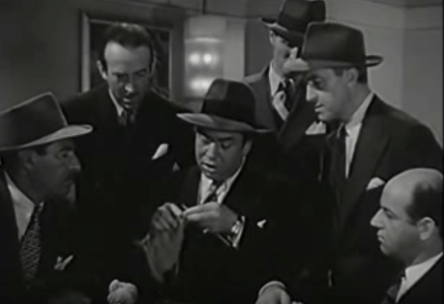

This week, we’ve been thinking and chatting about the relationship between gender and art/craft and in particular about the spectacle of the male knitter. It’s a big conversation, involving concepts like industrialization, domesticity, capitalism, “women’s work,” high versus low art, homophobia, sexism, ageism, yadda yadda yadda… It’s a conversation we want to keep having but certainly can’t fit into a single post. So today’s post is a little experiment: it’s a short-and-sweet critical essay on a popular instance of cinematic knitting—Mr. Lucky, starring the one and only Cary Grant—just to begin thinking through this question.
The film Mr. Lucky (1943) was based on a story called “Bundles for Freedom” by Milton Holmes, who also wrote the film’s screenplay. It features a classic moment of knitting on film, and captures a moment in American history when knitting was not only popular but almost mandatory in the name of patriotism. Watch this clip for the famous scene of Cary Grant getting lost in his stitches:
Before the U.S. entered World War II, everyone was encouraged to support our British allies by knitting up “Bundles for Britain.” After the U.S.’s entrance into the war, American men who weren’t off fighting—injured soldiers, unfit civilians, and others—could show their support by knitting up hats, sweaters, gloves, and other woolen items for the troops. Although the press often described it as a way for women and girls to support “our boys” abroad, these wartime knitters included not only women but men and children, too. So WWII (like the first WW before it) gave men a reason to publicly engage in a “feminine” activity. (See these fantastic posts from the Center for Knit and Crochet for more on knitting propaganda during WWI and WWII.)

Mr. Lucky capitalized on the phenomenon by inserting tough guy Joe (Cary Grant) into a war relief organization and seating him at the knitting table. In the famous scene, he is taught the basics by “our best instructor.” The scene aims for a comedic effect: Joe, a gambler, is scheming to steal relief money and only pretending to be dedicated to the cause. His love interest, Dorothy (Laraine Day), is rightly skeptical of his story, so her sending him to the knitting circle is a practical joke of sorts, a way to test his seriousness. I mean, only a man truly devoted to the cause would sacrifice his dignity by knitting! In public!

On top of the humor, Dorothy is also earnestly voicing a wartime PR strategy: in order to encourage more men to contribute to wartime knits, the sight of a man knitting needed to seem normal and downright masculine. So Dorothy wants “obviously masculine men” to be seen knitting “perfectly casually in public places.” Indeed, Joe gets seen. As he practices his stitches in the war relief office, a crowd gathers outside the plate-glass window.

Rather than overturn old notions about knitting and masculinity, however, the film ultimately reinscribes them. Joe only knits reluctantly—and poorly—while his driver and sidekick Crunk (Alan Carney) takes to it with zeal. Crunk continues to knit throughout the film and even shows off his skills to a crowd of men, as seen in the still below. Crunk is allowed to show effeminate eccentricity; Joe, our lead, is not. Joe must be distanced from the activity so as to uphold his status as a romantic male lead, while Crunk can proudly knit for comic relief and to throw Joe’s “obvious” masculinity into relief.

Even Dorothy, who first pointed Joe to the knitting table, ultimately tells him to put down his needles. This moment in the film coincides with the emergence of their romance and thus confirms that the dashing Grant would be made less attractive by such feminine associations. (This whole discussion could get even more interesting if we take into account that Grant, in real life, was not-quite-openly gay.) Anyway, while the knitting scenes in Mr. Lucky are amusing and reflect the era’s patriotic knitting push, the film still propagates conservative ideas about masculinity. After the war, these ideas came even more sharply into relief, as soldiers returned and the traditional gender roles that we now associate with the 1950s became the norm.
Over here at the Fiber Archive, we’re gonna keep thinking about this question of the gender of needlecraft by looking way back to mens-only knitting guilds, forward to Cold War homophobia and anti-consumerism, and even further forward to the “grandma” rhetoric that continues today. We’ll also just keep, you know, doing our thing: working on some more DIY projects, digging up historical gems, and even enlisting some exciting guest bloggers! See you next week…

Wow! Cant wait to read more! Book/further reading suggestions very welcome 😉
LikeLike